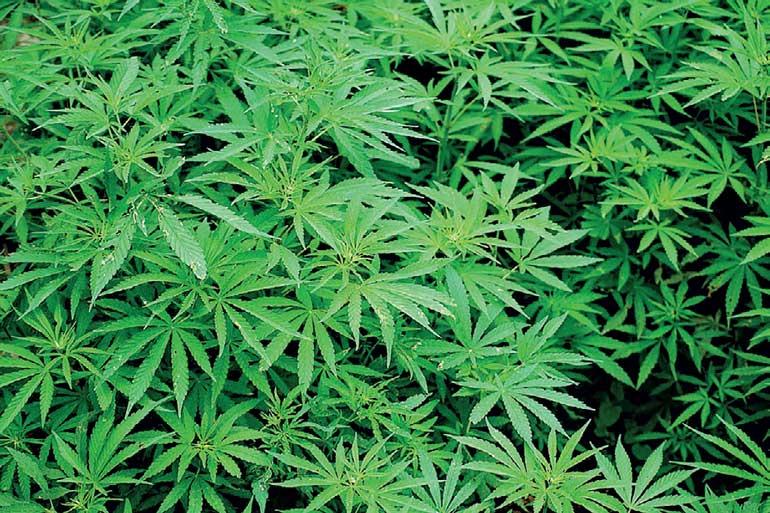Monday Apr 07, 2025
Monday Apr 07, 2025
Tuesday, 11 October 2022 00:06 - - {{hitsCtrl.values.hits}}

The short harvesting time (approximately four months) and the availability of a large extent of suitable lands in the dry zone justify Sri Lanka’s working on fast-track policies to legalise cannabis plantations for the export market
 The use of cannabis in medical applications has a long history of over 2,000 years, particularly in Asia and the Middle East. Some argue that it has a history of over 10,000 years. For example, in Asia, the Chinese herbal medicine, Indian (and most Southeast Asian countries, including Sri Lanka) Ayurvedic medicine, and Sri Lankan “Hela Vedakama” used cannabis as an essential ingredient in some of their medicines. The Guardian (https://www.theguardian.com/world/2003/jan/06/science.religion) referring to research studies records that “Jesus and his disciples used the drug to carry out miraculous healings”, illustrating the value of medicinal properties of cannabis” – particularly cannabis oil.
The use of cannabis in medical applications has a long history of over 2,000 years, particularly in Asia and the Middle East. Some argue that it has a history of over 10,000 years. For example, in Asia, the Chinese herbal medicine, Indian (and most Southeast Asian countries, including Sri Lanka) Ayurvedic medicine, and Sri Lankan “Hela Vedakama” used cannabis as an essential ingredient in some of their medicines. The Guardian (https://www.theguardian.com/world/2003/jan/06/science.religion) referring to research studies records that “Jesus and his disciples used the drug to carry out miraculous healings”, illustrating the value of medicinal properties of cannabis” – particularly cannabis oil.
In Sri Lanka, the British Colonial Government criminalised cannabis under “The Poisons, Opium and Dangerous Drugs Ordinance of 1935”. Although “The Ayurveda Act (Act No. 31 of 1961 as amended by Act No. 5 of 1962)” permits Ayurvedic physicians to obtain cannabis for medicinal preparations, Ayurvedic practitioners complain about the non-availability of high-quality cannabis in reliable sources.
Due to the continuous advocacy by Ayurvedic physicians and some scientists on the medicinal value of cannabis and the demand in the global market, there have been several attempts in the recent past to legalise cannabis for medical use and export market. A project was proposed to develop a 100-acre (40-hectare) cannabis farm in Ingiriya to produce about 25 tons a year to supply high-quality cannabis to the local Ayurvedic physicians and to export the balance. Although some ministers under the present Government positively advocated the need to capture the export market and legalise plantations, there has been an equal quantum of opposition from some politicians and some religious leaders. The writer could not get any information from a reliable source on the outcome of the Ingiriya project. However, what a stupid decision to start growing a dry zone plant in a wet zone location?
Having understood the massive global market for cannabis, some Asian countries have already softened their legal barriers to capture the global market. As a result, China and India have become forerunners, and Thailand recently entered the export market.
“The global medical cannabis market value stood at US$ 8 billion in 2018. The global market will likely rise at a CAGR of 26.6% during the forecast period from 2019 to 2027. The Future Market Outlook for Medical Cannabis predicts the market value to reach US$ 52.8 billion by 2027… The surge in medical cannabis demand is primarily supported by research and scientific developments that provide valuable insights into the possible advantages of medicinal cannabis in treating various ailments.” (Source:
(https://www.prnewswire.com/news-releases/medical-cannabis-market-is-estimated-to-rise-at-a-cagr-of-26-6-during-the-forecast-period-observes-tmr-study-301553574.html)
https://www.worldstopexports.com reports that in 2019 by value, the top listed 15 countries shipped 87.6% of global cannabis oil exports. Of these 15 countries, five are from Asia (excluding Madagascar). The value of their exports earnings was recorded as (i) China: $ 964 million (33.4%), (ii) India: $ 320.8 million (11.1%), South Korea: $ 59.7 million (2.1%), (iv) Vietnam: $ 54.3 million (1.9%), and Madagascar: $ 34.7 million (1.2%). It further records that, “Among the top exporters, the fastest-growing exporters of cannabis oils since 2015 were: Vietnam (up 529.5%), Madagascar (up 232.2%), Morocco (up 218.1%) and Netherlands (up 124.5%)”. The total value of cannabis oil exports stood at $ 2.9 billion in 2019. CBD oil and THC oils are the most value-added cannabis products.
https://www.healthline.com/nutrition/cbd-oil-benefits indicates six health benefits of cannabis oil, known as CBD oil. CBD is extracted from the cannabis plant and diluted with a carrier oil, such as coconut oil, to produce CBD oil. Sri Lanka has an excellent opportunity to make CBD oil, as coconut oil is now globally recognised as having high medicinal value. CBD with coconut oil can create a brand name if produced in Sri Lanka.
Most of the dry zone areas in Sri Lanka are fertile for cannabis plantations and consist of large extents of undeveloped/underdeveloped lands that can be easily put to such plantations. Cannabis plantations in Sri Lanka are illegally operated in forests or abandoned “Chena” areas in remote dry zones areas.
Currently, most of such “illegal cannabis plantations” are found in Hambantota district consisting of eight Divisional Secretariats and Monaragala district consisting of 11 Divisional Secretariats. Of the 19 Divisional Secretariats in Hambantota and Monaragala districts, I am presenting below the extent of potential lands available for cannabis plantations only in five Divisional Secretariats, namely Ambalantota, Hambantota, Lunugamvehera, Sooriyawewa, and Tissamarama as a sample. The total suitable land extent available is 47,072 hectares. This is after the conservation of 45,230 hectares as forest reserves.
The short harvesting time (approximately four months) and the availability of a large extent of suitable lands in the dry zone justify Sri Lanka’s working on fast-track policies to legalise cannabis plantations for the export market. The urgent activities required are:
Sri Lanka (as always, the case) is already late in capturing the global opportunity. China, India, Vietnam, Madagascar, and Thailand have taken the lead role, and Pakistan will enter the market soon. Thus, urgent steps are needed to make cannabis a significant source of export earnings. Of the estimated $ 52.8 billion worth of global cannabis market, if Sri Lanka can target capturing 4%, that will generate $ 2.0 billion of foreign exchange per annum. Since cannabis has a short harvesting period (approximately four months). Further, a well-conceived financing structure can create foreign exchange accounts for every grower, which could be an effective instrument to prevent the loss of foreign exchange due to mis-invoicing.
Can we do it now? Or record it as another lost opportunity as we have always been doing in the past. Finally, I record my sincere appreciation to the State Minister of Tourism Diana Gamage, for creating a true voice for new opportunities in the global market fearlessly.

(The writer is Fellow, Institute of Town Planners Sri Lanka (FITPSL), Honorary Fellow, Planning Institute of Australia (HFPIA), and Past President, Institute of Town Planners, Sri Lanka. He could be reached via email at [email protected].)
Discover Kapruka, the leading online shopping platform in Sri Lanka, where you can conveniently send Gifts and Flowers to your loved ones for any event including Valentine ’s Day. Explore a wide range of popular Shopping Categories on Kapruka, including Toys, Groceries, Electronics, Birthday Cakes, Fruits, Chocolates, Flower Bouquets, Clothing, Watches, Lingerie, Gift Sets and Jewellery. Also if you’re interested in selling with Kapruka, Partner Central by Kapruka is the best solution to start with. Moreover, through Kapruka Global Shop, you can also enjoy the convenience of purchasing products from renowned platforms like Amazon and eBay and have them delivered to Sri Lanka.
Discover Kapruka, the leading online shopping platform in Sri Lanka, where you can conveniently send Gifts and Flowers to your loved ones for any event including Valentine ’s Day. Explore a wide range of popular Shopping Categories on Kapruka, including Toys, Groceries, Electronics, Birthday Cakes, Fruits, Chocolates, Flower Bouquets, Clothing, Watches, Lingerie, Gift Sets and Jewellery. Also if you’re interested in selling with Kapruka, Partner Central by Kapruka is the best solution to start with. Moreover, through Kapruka Global Shop, you can also enjoy the convenience of purchasing products from renowned platforms like Amazon and eBay and have them delivered to Sri Lanka.